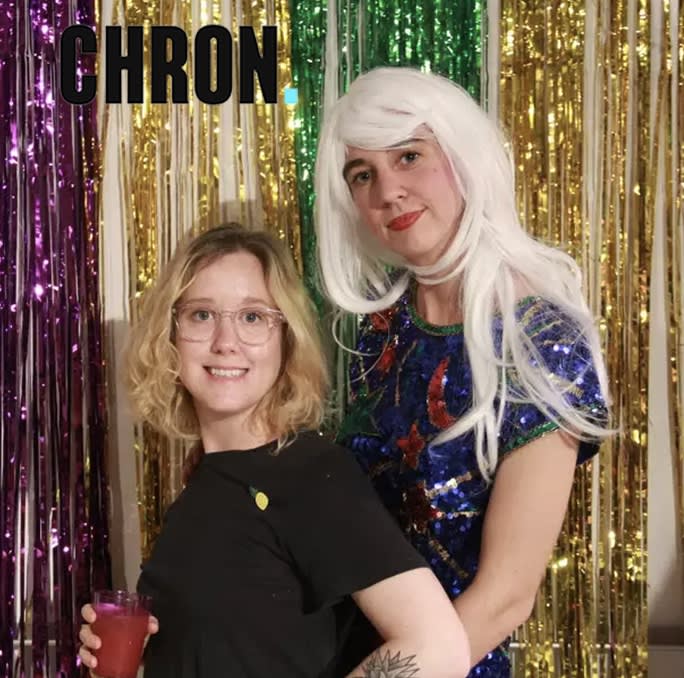Kinnaird is known for her blend of eccentric paintings and mixed-media sculptures that utilize humor as a tactic of engagement. She describes herself as a multimedia artist, a mode that showcases the ever-present diversity binding her work.
Duos occupy an essential place in art, culture and society, as they confirm the compatibility of difference. When used as subjects in art, they might suggest something deeper about the world they occupy, or even act as a mirror for the past or the future. But in Arm Candy, the show on display at San Jacinto College’s South Campus Art Gallery between Jan. 29 and March 9, they represent the collaboration between two of Houston’s most thoughtfully provocative artists, Iva Kinnaird and Emily Peacock.
They met nearly a decade ago when Kinnaird applied to Lawndale Art Center’s artist residency program in Houston, where Peacock then served as one of the judges. And just like the untold number of other Houston artists making friends over drinks, they cemented their bond at the Museum District’s unofficial watering hole, Grand Prize Bar. Earlier this year, they were each individually approached by San Jacinto College gallery curator and art professor Bradly Brown to exhibit solo shows, but given their friendship, Kinnaird suggested they host a two-person show instead and Peacock agreed.
“We are both oddball women artists and have similar views on art and life,” Peacock said: “I don't want to speak for Iva, but I feel like we both take risks in our art practice, and we also have a similar sense of humor.”
“We've been friends for years and I've always enjoyed keeping up with her varied forms of work—photography, film, comedy, house gallery, etc. Doing an exhibition together just made sense,” Kinnaird said.
Peacock, who is also a mother, professor of art at Sam Houston State University and stand-up comedian working around Houston, infuses much of her art—whether visual or performance-based—with comedic self-deprecation. She views it, in her words, as a “coping mechanism, emphasizing the tension between emotional vulnerability and extroversion,” and uses it as a tactic to include in photographs, films, sculptures and installations that "offer an uncanny perspective on our digitally dominated world.”
She often re-imagines themes of life, love and loss with the brutal honesty needed to induce both laughter and cringe, a reaction that she cites as essential to her practice.
“I think I say multimedia artist because in school I saw a lot of Laurie Anderson performances and her speaking, and she said you can say multimedia artist and that covers everything,” Kinnaird said. “As an artist, I jump around a lot. I sort of follow whatever idea seems interesting. A lot of the stuff is just inspired by the materials themselves.”
Because the works in Arm Candy weren’t for sale, the show functioned much like a museum exhibit. This liberation from any commercial constraints freed the artists to include more unconventional pieces, or as Peacock describes it, the show was “an opportunity to mess around.” And because the artists still own these works, the pieces have more potential to further influence future work as they continue to co-habitate their space.
As evidenced in Arm Candy, both artists routinely examine themes of Americana, including subjects like hot dogs, popsicles and light beer, among many. To label these references a cut-and-dry recycling of pop art examples like Andy Warhol’s Campbell’s Soup Cans (1962), would be too easy. Unlike the emotional detachment sometimes associated with Warhol’s robotic repetition of images, these works add a more human element. They infuse a touch of levity that could never be associated with his infamous mantra "I want to be a machine." I mean, what machine has the self-awareness to admit that their take-it-or-leave-it style of extroverted personality might be Too Much for Most or enjoys the not-so-guilty pleasure of a cold Shower Beer.
Bringing it back to a city they have grown to love, both artists position Houston as an art city with tremendous staying power. And although they weren’t brought up here, they feel at home in Houston as a dynamic art environment. Kinnaird describes Houston’s dramatic sprawl as beneficial to artistic diversity.
“Houston has a sprawl to it that makes it feel like there are distinct pockets of art activity, each with slightly different vibes. I like to visit them like islands,” Kinnaird said.
And although filtering Houston’s art scene in this way might suggest isolation, she states “that if you go to enough events and see the same people, it starts to feel smaller. It’s easy to meet people in the art scene here, and most places feel welcoming. They’re just happy for people to show up … [Houston] has a slightly less crushing economic experience, which allows more space and time to think about making art. It’s big enough to not feel claustrophobic.”
Peacock has lived in Houston for decades and found it similarly welcoming over the years.
“Houston is unique because it is affordable, diverse, friendly and the fourth-largest city in the U.S.,” Peacock said. “I have always felt supported by the Houston art community in whatever strange endeavor I was working on, whether it be an exhibition in the back of a U-Haul, a film screening, or stand-up as an artist talk. I feel very close to many artists in town—we've grown up together at this point.”
Peacock and Kinnaird both express optimism about future projects. Kinnaird recently took a job as the facilities manager at the Houston Center for Contemporary Craft and is working alongside the Center’s curator Sarah Darro to design some exciting new shows. Peacock has an upcoming solo show this summer at Seven Sisters, one of Houston’s newest and most anticipated art galleries, run by Erin Dorn.
Both artists enthusiastically express interest in other collaborations, as well. Kinnaird describes such prospects with her characteristic sense of levity: “We discussed some performance and video pieces that we could still do ... as long as we don’t get arrested.”

